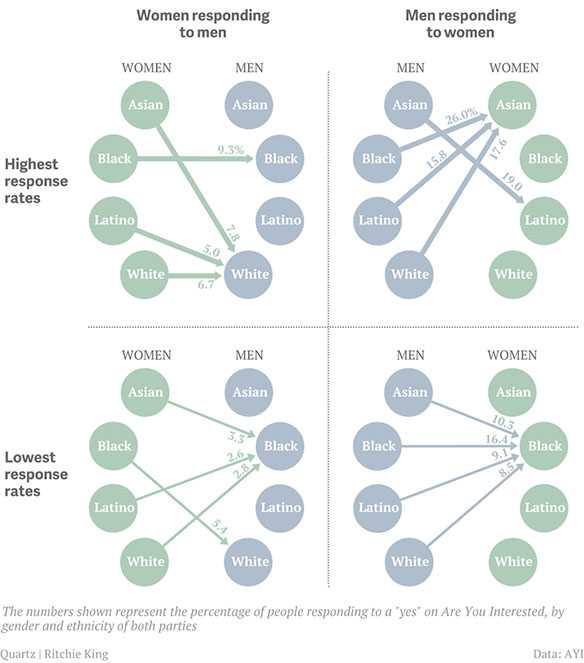Quartz, a business website from The Atlantic Media Company, recently released data on the Facebook dating app Are You Interested, which connects single people with others within the confines of their Facebook networks. Quartz’s data are based on a series of yes-or-no questions about who users are interested in, as well as response rates between users, once notified of a potential suitor. The data show that white men and Asian women receive the most interest, whereas black men and black women receive the least amount of interest. The writers at Quartz summarize the findings as follows:
Unfortunately the data reveal winners and losers. All men except Asians preferred Asian women, while all except black women preferred white men. And both black men and black women got the lowest response rates for their respective genders.
Here’s what the data look like:

As a sociologist, I am entirely unsurprised that race matters, especially in such a personal process like dating/mating. However, these findings may come as a surprise to the (quite significant) segments of the population who identify as color-blind; those who label contemporary society post-racial.
And this is why dating sites are so cool. Social psychologists know that what people say and what they do have little empirical connection. Dating sites capture what we do, and play it back for us. They expose who we are, who we want, and, of course, who we don’t want. As shown by Quartz, “we” fetishize Asian women while devaluing blacks.
With a schism between what people say and what they do—between what they say and what they unconsciously think—surveys of racial attitudes are always already quite limited. People can say whatever they want—that race doesn’t matter, that they don’t see color—but when it comes to selecting a partner, and the selection criteria are formalized through profiles and response decisions, we, as individuals and a society, can no longer hide from ourselves. The numbers blare back at us, forcing us to prosume uncomfortable cultural and identity meanings both personally and collectively.
Indeed, before anyone has answered anything, the architecture of online dating sites say a lot. Namely, by defining what can be preferences at all, they tell us which characteristics are the ones about which we are likely to care, and about which we should care.
Both the user data and the presence of racial identification and preference in the first place are revealing, demolishing arguments about colorblindness and post-racial culture.
This post originally appeared on Sociological Images, a Pacific Standard partner site.





